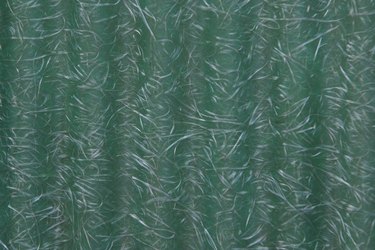
Various finely ground, abrasive materials are used to sandblast paint, dirt, mold and other items from surfaces as well as to abrade surfaces mildly to improve their adhesion with a product. Depending on the sandblasting material and the sandblaster's pressure setting and proximity to the surface, damage to the substrate can result. That is especially true of fiberglass, which is softer than steel. Deep scratches and even holes may occur in fiberglass if care is not taken during sandblasting.
Fiberglass
Video of the Day
Also known as fibrous glass and glass wool, fiberglass consists of woven glass fibers. By definition, a fiber is a particle that is at least three times longer than it is wide. Fiberglass has a variety of uses, from lining pre-1930s duct work in homes to boat and automobile material and just about anything between. It forms slight peaks and valleys. When sanded by hand, it can have an uneven appearance. Sandblasting smooths the unevenness and, when done correctly, results in a clean, flawless finish.
Video of the Day
Sandblast
Sandblast can be a number of minerals, sand or metal particles. Sand commonly is used because it is less expensive than other less abrasive blasting media and works well on many materials. The hardness and sharp edges of sand grains, however, can damage fiberglass. Among other blasting media used are staurlite, garnet, aluminum oxide and sodium bicarbonate.
Soda Blasting
The use of sodium bicarbonate, or baking soda, to sandblast fiberglass is quickly becoming the norm. Soda blasting removes paint and gel coats, dirt, debris, mold and other matter without scratching or marring the fiberglass substrate. Sodium bicarbonate is classified as a mild abrasive. It is safe for use in kitchens and food handling and storage areas. Soda blasting removes auto paint from an entire vehicle in just a few hours with no damage to the substrate.
Health Concerns
Regardless of the blasting media used, fiberglass substrates pose dangers. The tiny glass fibers are easily inhaled, and the smaller the particles, the more deeply they can travel into lungs. Although no solid scientific evidence exists that fiberglass causes cancer, it is widely believed that inhaling it and allowing it to contact skin should be avoided. Wear a good quality respirator, and keep exposed skin covered when working with fiberglass. Wash fiberglass-exposed clothing separately with soap and warm water.